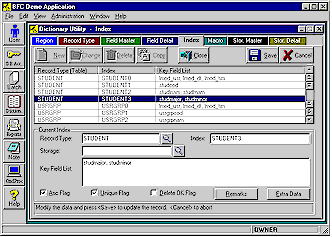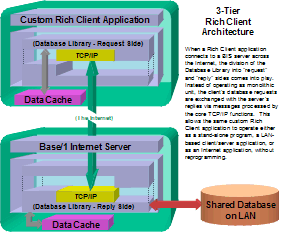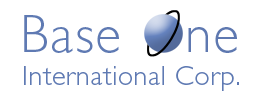|
|
|
Working with the Leading Databases |
Base One is integrated with
commercial database environments
- Support for the
major database standards
The Base One Foundation Component Library (BFC) operates through ODBC
drivers for
Microsoft SQL Server and Access, Oracle,
IBM DB2,
Sybase, and MySQL.
(On the other hand, B1Framework operates through ADO.NET data providers.)
Databases can reside on Windows, Unix/Linux, and IBM midrange
(iSeries) and mainframe servers.
- Integration into Windows development and
runtime environments
 With
integrated development under Visual
Studio .NET, BFC applications run on Microsoft Windows PCs
and servers. Base One supports
traditional, client-server and multi-tier Windows applications, as
well as both web
browser-based "thin client" and
Rich
Client Internet applications. Rich Client avoids the need for browsers
altogether by using Windows' built-in TCP/IP communications
functions, allowing for custom encryption as an added security
measure. Through XML and web services, Base One can exchange
data with J2EE, legacy, and hand-held database applications. The
architecture is also well adapted to other types of loosely
coupled systems, such as database-driven web sites
in combination with Rich Client applications to perform
administrative tasks, web site operations,
and distributed computing for high-speed, bulk data processing. With
integrated development under Visual
Studio .NET, BFC applications run on Microsoft Windows PCs
and servers. Base One supports
traditional, client-server and multi-tier Windows applications, as
well as both web
browser-based "thin client" and
Rich
Client Internet applications. Rich Client avoids the need for browsers
altogether by using Windows' built-in TCP/IP communications
functions, allowing for custom encryption as an added security
measure. Through XML and web services, Base One can exchange
data with J2EE, legacy, and hand-held database applications. The
architecture is also well adapted to other types of loosely
coupled systems, such as database-driven web sites
in combination with Rich Client applications to perform
administrative tasks, web site operations,
and distributed computing for high-speed, bulk data processing.
- Adding a layer of
protection and portability
BFC wraps the underlying database functions in an easy-to-learn interface, accessible through
.NET, COM,
and MFC, so Windows and web database applications can be developed quickly using Visual C++, C#, Visual Basic, VB.NET, ASP, and
ASP.NET.
An additional layer of protection comes from Base One's integral
transaction processing and security mechanisms, which tie into and extend existing database and network authentication and
reliability features. Using a single, common API
(Application Program Interface), you can create applications
that work against interchangeable back-end databases, whether on a
local network or in a heterogeneous, distributed system across
the Internet.
|
Base One extends and enhances
native DBMS capabilities
- DBMS-independent extensions
through Base One's active Data Dictionary
 The Data Dictionary, an integral component used throughout
BFC,
supports a number of significant extensions to the native
capabilities of commercial database systems. Base One adds such
features as application-level security, enhanced data validation,
referential relationships,
and support for advanced data types (Number Class and
Attached Objects),
all with a uniform, database-independent interface. The Data
Dictionary also enables discovery and automatic generation of database layouts, indexes,
DBMS security settings, and application-specific performance optimizations. The Data Dictionary, an integral component used throughout
BFC,
supports a number of significant extensions to the native
capabilities of commercial database systems. Base One adds such
features as application-level security, enhanced data validation,
referential relationships,
and support for advanced data types (Number Class and
Attached Objects),
all with a uniform, database-independent interface. The Data
Dictionary also enables discovery and automatic generation of database layouts, indexes,
DBMS security settings, and application-specific performance optimizations.
- Powerful administrative
tools that work both locally and remotely
Even a non-programmer can use the Base One Command
Processor, capable of running complex scripts including SQL and DOS commands,
plus commands for easily performing such tasks
as automated database creation or running pre-defined jobs.
With customizable facilities for batch
processing (job submission, scheduling, monitoring, and
control),
as well as security and user
administration, almost any aspect of
back-office database support can be handled remotely.
|
Base One makes it easier to build enterprise database applications
- Easy to learn and use
Aided by sample projects and
integrated
wizards, the BFC
interface is easy to learn, because operations for data storage and retrieval are expressed the same way, whether programmed in .NET, COM, or MFC environments,
or through command scripts.
Base One makes life easier by freeing programmers and database
administrators from concern about tedious details
that make all the difference between a prototype and a robust,
high performance, production system. This
makes it possible to develop and maintain large-scale interactive or batch
applications with the same tools and skill level required for small database
projects.
- Built for speed and reliability, without
added complexity
 BFC's core
Database Library incorporates a highly efficient
mode of automated transaction processing and rigorous error
handling, to assure
proper synchronization
of multi-user access and clean recovery from failures. Further
speedups are achieved through intelligent client-side caching of data and metadata,
plus bulk import,
export, and data manipulation operations, optimized for each
back-end DBMS, and designed to minimize locking out concurrent database activity.
On top of this solid foundation, Base One's Rich Client architecture makes maximum use of the client computer's local
storage and processing capabilities, minimizing network traffic
and reducing the load on database servers. The result is that
applications can scale to larger size and support more
users, while maintaining rapid response time. BFC's core
Database Library incorporates a highly efficient
mode of automated transaction processing and rigorous error
handling, to assure
proper synchronization
of multi-user access and clean recovery from failures. Further
speedups are achieved through intelligent client-side caching of data and metadata,
plus bulk import,
export, and data manipulation operations, optimized for each
back-end DBMS, and designed to minimize locking out concurrent database activity.
On top of this solid foundation, Base One's Rich Client architecture makes maximum use of the client computer's local
storage and processing capabilities, minimizing network traffic
and reducing the load on database servers. The result is that
applications can scale to larger size and support more
users, while maintaining rapid response time.
Building still
further upon the Rich Client model, Base One's unique approach to grid computing
offers superior performance, flexibility, and fault-tolerance in
the largest distributed database applications. Best of all,
application development is easy, because the features essential
to achieving speed and dependability in large, multi-user
systems are already built into Base One.
|
|

